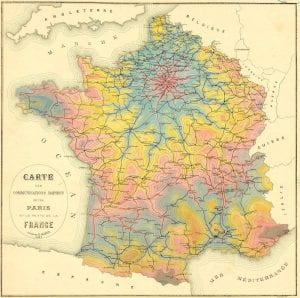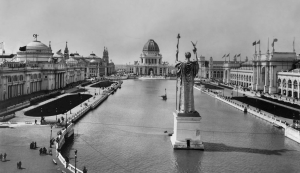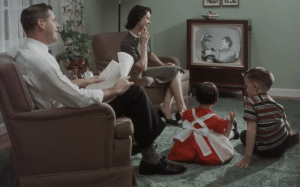Isochrone maps old and new
You’re in the middle of working on your “walk scores” assignment. Note that the walkscore.com website includes travel time maps, which show how far you can get in any direction from a particular address in a given amount of time. Maps based on this idea of isochrony go back at least to the 1880s, and sometimes covered whole countries or the world, as described in this Atlas Obscura article: “Traveling Back in Time With Colorful Isochrone Maps.”
This is the song Heller mentioned in the essay you read for today. The Smiths were everything to a certain kind of high school kid in the 80s.
Levittown, PA
Click above for the March of Time story about the building of Levittown. Also, the video below, “Crisis in Levittown,” provides contemporary coverage of the controversy surrounding the first black family moving in to Levittown in 1957.
We gotta little convoy…
Today we were discussing the rise of the motorcar and the good roads movement of the early 20th century. Here is an entertaining account in Atlas Obscura of the 1919 military convoy from D.C. to California that helped to convince Eisenhower, who went along for the ride, that America could use a better system of national highways.
Brand new Chinese ghost towns
We were talking about New Towns recently. Here are some examples of how to do it badly – whole new cities built from scratch in China with hardly anyone living in them.
Here’s another story along the same lines: the Chinese government built a replica of Paris that is now mostly abandoned.
And here’s one more article about these places; the author says the Chinese New Towns are sparsely populated, but certainly not empty, and the term “ghost town” is an exaggeration.
A call to end time zones
Check out this New York Times opinion piece in which author James Gleick calls for abolishing time zones. If he and like-minded reformers were to get their way, we in Texas would be eating dinner at what used to be called midnight.
“The Death of Public Beauty”
Conservative academic and architecture critic Michael J. Lewis speaks to several topics we’re covering this week, including the City Beautiful movement, Jane Jacobs, and the goals of urban planning, in this article from the last issue of National Review: “The Death of Public Beauty: How City Planning Went Wrong.”
COVID and urban planning
We’ll be talking about urban planning next week. The disruptions of the COVID-19 pandemic are inviting some to think BIG, going so far as to suggest that we should use this opportunity to revise cities to operate in new ways, by, for instance, more or less…
abolishing cars: “American Cities Are Built for Cars. The Coronavirus Could Change That.”
or
abolishing families: “Covid-19 Is Straining the Concept of the Family. Let’s Break It.”
Selling the idea of Austin as the live music capital of the world
Here’s the KUT story I mentioned in class. It describes how bigwigs in Austin worked to brand Austin as the “live music capital of the world.”









